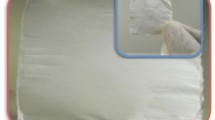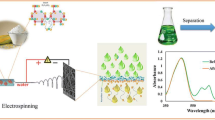Abstract
Paracetamol is a widely used as an analgesic and an antipyretic that can easily accumulate in aquatic environments. This study aimed to enhance paracetamol removal efficiency from water by combining the biocatalytic activity of horseradish peroxidase (HRP) with the adsorption of nanofibrous membrane. Poly(vinyl alcohol)/poly(acrylic acid)/SiO2 electrospinning nanofibrous membrane was prepared with fiber diameters of 200 to 300 nm. The membrane was made insoluble by the thermal cross-linking process. HRP, which was previously activated by 1,1′-carbonyldiimidazole, was covalently immobilized on the surface of nanofibers. Immobilized HRP retained 79.4 % of the activity of free HRP. The physical, chemical, and biochemical properties of the immobilized HRP and its application in paracetamol removal were comprehensively investigated. Immobilized HRP showed better storage capability and higher tolerance to the changes in pH and temperature than free HRP. Paracetamol removal rate by immobilized HRP (83.5 %) was similar to that of free HRP (84.4 %), but immobilized HRP showed excellent reusability. The results signify that enzyme immobilized on nanofibers has great application potential in water treatment.








Similar content being viewed by others
References
Ba S et al (2014) Synthesis and characterization of combined cross-linked laccase and tyrosinase aggregates transforming acetaminophen as a model phenolic compound in wastewaters. Sci Total Environ 487:748–755. doi:10.1016/j.scitotenv.2013.10.004
Bai Y-X, Li Y-F, Wang M-T (2006) Study on synthesis of a hydrophilic bead carrier containing epoxy groups and its properties for glucoamylase immobilization. Enzym Microb Technol 39:540–547. doi:10.1016/j.enzmictec.2005.08.041
Basturk E, Demir S, Danis O, Kahraman MV (2013) Covalent immobilization of a-amylase onto thermally crosslinked electrospun PVA/PAA nanofibrous hybrid membranes. J Appl Polym Sci 127:349–355. doi:10.1002/app.37901
Cabrita I, Ruiz B, Mestre AS, Fonseca IM, Carvalho AP, Ania CO (2010) Removal of an analgesic using activated carbons prepared from urban and industrial residues. Chem Eng J 163:249–255. doi:10.1016/j.cej.2010.07.058
Caramori SS, Fernandes KF (2004) Covalent immobilisation of horseradish peroxidase onto poly(ethylene terephthalate)–poly(aniline) composite. Process Biochem 39:883–888. doi:10.1016/S0032-9592(03)00188-2
Cristóvão RO, Tavares AP, Brígida AI, Loureiro JM, Boaventura RA, Macedo EA, Coelho MAZ (2011) Immobilization of commercial laccase onto green coconut fiber by adsorption and its application for reactive textile dyes degradation. J Mol Catal B Enzym 72:6–12. doi:10.1016/j.molcatb.2011.04.014
Dai YR, Niu JF, Liu J, Yin LF, Xu JJ (2010) In situ encapsulation of laccase in microfibers by emulsion electrospinning: preparation, characterization, and application. Bioresour Technol 101:8942–8947. doi:10.1016/j.biortech.2010.07.027
De Gusseme B, Vanhaecke L, Verstraete W, Boon N (2011) Degradation of acetaminophen by Delftia tsuruhatensis and Pseudomonas aeruginosa in a membrane bioreactor. Water Res 45:1829–1837. doi:10.1016/j.watres.2010.11.040
Greiner A, Wendorff JH (2007) Electrospinning: a fascinating method for the preparation of ultrathin fibres. Angew Chem Int Edit 46:5670–5703. doi:10.1002/anie.200604646
Gros M, Petrović M, Barceló D (2006) Development of a multi-residue analytical methodology based on liquid chromatography–tandem mass spectrometry (LC–MS/MS) for screening and trace level determination of pharmaceuticals in surface and wastewaters. Talanta 70:678–690. doi:10.1016/j.talanta.2006.05.024
Heberer T (2002) Tracking persistent pharmaceutical residues from municipal sewage to drinking water. J Hydrol 266:175–189. doi:10.1016/S0022-1694(02)00165-8
Hermanson GT (2013) Bioconjugate techniques. Academic
Huang Z-M, Zhang Y-Z, Kotaki M, Ramakrishna S (2003) A review on polymer nanofibers by electrospinning and their applications in nanocomposites. Compos Sci Technol 63:2223–2253. doi:10.1016/S0266-3538(03)00178-7
Huang X-J, Yu A-G, Xu Z-K (2008) Covalent immobilization of lipase from Candida rugosa onto poly(acrylonitrile-co-2-hydroxyethyl methacrylate) electrospun fibrous membranes for potential bioreactor application. Bioresour Technol 99:5459–5465. doi:10.1016/j.biortech.2007.11.009
Husain Q, Ulber R (2011) Immobilized peroxidase as a valuable tool in the remediation of aromatic pollutants and xenobiotic compounds: a review. Crit Rev Environ Sci Technol 41:770–804. doi:10.1080/10643380903299491
Jørgensen SE, Halling-Sørensen B (2000) Drugs in the environment. Chemosphere 40:691–699
Joss A et al (2006) Biological degradation of pharmaceuticals in municipal wastewater treatment: proposing a classification scheme. Water Res 40:1686–1696. doi:10.1016/j.watres.2006.02.014
Kim YH et al (2013) Enhanced stability and reusability of marine epoxide hydrolase using ship-in-a-bottle approach with magnetically-separable mesoporous silica. J Mol Catal B Enzym 89:48–51. doi:10.1016/j.molcatb.2012.12.012
Kolpin DW, Furlong ET, Meyer MT, Thurman EM, Zaugg SD, Barber LB, Buxton HT (2002) Pharmaceuticals, hormones, and other organic wastewater contaminants in US streams, 1999–2000: a national reconnaissance. Environ Sci Technol 36:1202–1211. doi:10.1021/es011055j
Larson AM et al (2005) Acetaminophen-induced acute liver failure: results of a United States multicenter, prospective study. Hepatology 42:1364–1372. doi:10.1002/hep.20948
Li L, Hsieh Y-L (2005) Ultra-fine polyelectrolyte hydrogel fibres from poly(acrylic acid)/poly(vinyl alcohol). Nanotechnology 16:2852. doi:10.1088/0957-4484/16/12/020
Lin J, Ding B, Yang J, Yu J, Sun G (2012) Subtle regulation of the micro- and nanostructures of electrospun polystyrene fibers and their application in oil absorption. Nanoscale 4:176–182. doi:10.1039/C1NR10895F
Liu J-Z, Song H-Y, Weng L-P, Ji L-N (2002) Increased thermostability and phenol removal efficiency by chemical modified horseradish peroxidase. J Mol Catal B Enzym 18:225–232. doi:10.1016/S1381-1177(02)00100-5
Liu Q, Kong X, Zhang C, Chen Y, Hua Y (2013) Immobilisation of a hydroperoxide lyase and comparative enzymological studies of the immobilised enzyme with membrane-bound enzyme. J Sci Food Agric 93:1953–1959. doi:10.1002/jsfa.5997
Magri ML, De Las Nieves Loustau M, Victoria Miranda M, Cascone O (2007) Immobilisation of soybean seed coat peroxidase on its natural support for phenol removal from wastewater. Biocatal Biotransfor 25:98–102. doi:10.1080/10242420601142992
Maloney SW, Manem J, Mallevialle J, Fiessinge F (1986) Transformation of trace organic compounds in drinking water by enzymic oxidative coupling. Environ Sci Technol 20:249–253. doi:10.1021/es00145a004
Meloun M, Syrový T, Vrána A (2005) The thermodynamic dissociation constants of losartan, paracetamol, phenylephrine and quinine by the regression analysis of spectrophotometric data. Anal Chim Acta 533:97–110. doi:10.1016/j.aca.2004.11.007
Mohamed SA, Al-Malki AL, Kumosani TA, El-Shishtawy RM (2013) Horseradish peroxidase and chitosan: activation, immobilization and comparative results. Int J Biol Macromol 60:295–300. doi:10.1016/j.ijbiomac.2013.06.003
Monier M, Ayad D, Wei Y, Sarhan A (2010) Immobilization of horseradish peroxidase on modified chitosan beads. Int J Biol Macromol 46:324–330. doi:10.1016/j.ijbiomac.2009.12.018
Mrozik A, Hupert-Kocurek K, Nowak B, Labuzek S (2008) Microbial lipases and their significance in the protection of the environment. Post Mikrobiol 47:43–50
Onesios KM, Jim TY, Bouwer EJ (2009) Biodegradation and removal of pharmaceuticals and personal care products in treatment systems: a review. Biodegradation 20:441–466. doi:10.1007/s10532-008-9237-8
Osma JF, Toca-Herrera JL, Rodriguez-Couto S (2010) Biodegradation of a simulated textile effluent by immobilised-coated laccase in laboratory-scale reactors. Appl Catal A Gen 373:147–153. doi:10.1016/j.apcata.2009.11.009
Potter DW, Miller DW, Hinson JA (1985) Identification of acetaminophen polymerization products catalyzed by horseradish peroxidase. J Biol Chem 260:12174–12180
Pramparo L, Stuber F, Font J, Fortuny A, Fabregat A, Bengoa C (2010) Immobilisation of horseradish peroxidase on Eupergit (R) C for the enzymatic elimination of phenol. J Hazard Mater 177:990–1000. doi:10.1016/j.jhazmat.2010.01.017
Ranieri E, Verlicchi P, Young TM (2011) Paracetamol removal in subsurface flow constructed wetlands. J Hydrol 404:130–135. doi:10.1016/j.jhydrol.2011.03.015
Sari M, Akgöl S, Karatas M, Denizli A (2006) Reversible immobilization of catalase by metal chelate affinity interaction on magnetic beads. Ind Eng Chem Res 45:3036–3043. doi:10.1021/ie0507979
Selvakannan PR, Mantri K, Tardio J, Bhargava SK (2013) High surface area Au-SBA-15 and Au-MCM-41 materials synthesis: tryptophan amino acid mediated confinement of gold nanostructures within the mesoporous silica pore walls. J Colloid Interface Sci 394:475–484. doi:10.1016/j.jcis.2012.12.008
Sheldon RA (2007) Enzyme immobilization: the quest for optimum performance. Adv Synth Catal 349:1289–1307. doi:10.1002/adsc.200700082
Sill TJ, von Recum HA (2008) Electro spinning: applications in drug delivery and tissue engineering. Biomaterials 29:1989–2006. doi:10.1016/j.biomaterials.2008.01.011
Teng MM, Wang HT, Li FT, Zhang BR (2011) Thioether-functionalized mesoporous fiber membranes: sol-gel combined electrospun fabrication and their applications for Hg2+ removal. J Colloid Interface Sci 355:23–28. doi:10.1016/j.jcis.2010.11.008
Wan L-S, Ke B-B, Xu Z-K (2008) Electrospun nanofibrous membranes filled with carbon nanotubes for redox enzyme immobilization. Enzym Microb Technol 42:332–339. doi:10.1016/j.enzmictec.2007.10.014
Wu S, Zhang L, Chen J (2012) Paracetamol in the environment and its degradation by microorganisms. Appl Microbiol Biotechnol 96:875–884. doi:10.1007/s00253-012-4414-4
Xu R, Chi C, Li F, Zhang B (2013a) Immobilization of horseradish peroxidase on electrospun microfibrous membranes for biodegradation and adsorption of bisphenol A. Bioresour Technol 149:111–116. doi:10.1016/j.biortech.2013.09.030
Xu R, Zhou Q, Li F, Zhang B (2013b) Laccase immobilization on chitosan/poly(vinyl alcohol) composite nanofibrous membranes for 2,4-dichlorophenol removal. Chem Eng J 222:321–329. doi:10.1016/j.cej.2013.02.074
Acknowledgments
This study was funded by the National Natural Science Foundation of China (51208368). The authors are also grateful for the financial support from the Ministry of Science and Technology, China (Nos. 2010DFA92820 and 2010DFA92800).
Author information
Authors and Affiliations
Corresponding author
Additional information
Responsible editor: Angeles Blanco
Rights and permissions
About this article
Cite this article
Xu, R., Si, Y., Li, F. et al. Enzymatic removal of paracetamol from aqueous phase: horseradish peroxidase immobilized on nanofibrous membranes. Environ Sci Pollut Res 22, 3838–3846 (2015). https://doi.org/10.1007/s11356-014-3658-1
Received:
Accepted:
Published:
Issue Date:
DOI: https://doi.org/10.1007/s11356-014-3658-1




